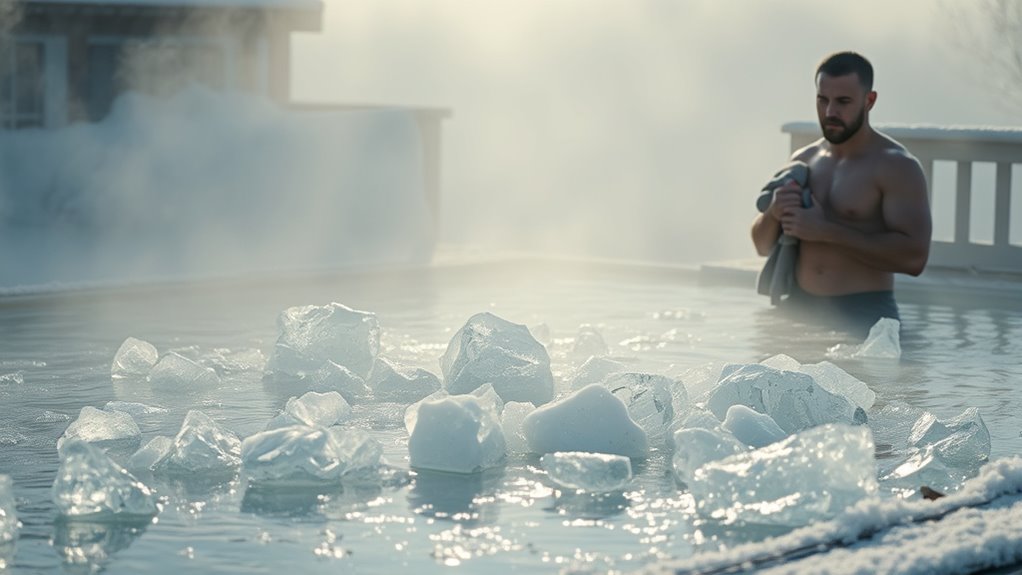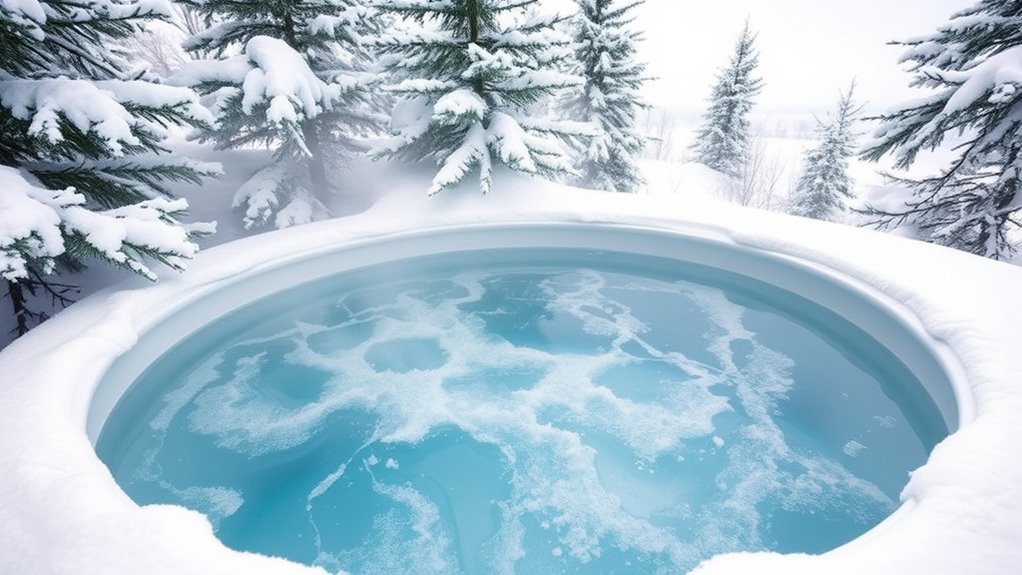Cold plunging can boost your recovery by reducing muscle soreness and inflammation, while also building mental toughness and focus. It constricts blood vessels to limit swelling and flushes out waste products. However, it carries risks like cold shock, hypothermia, and strain on your heart, especially if you have underlying health issues. Using ice baths safely involves gradual adaptation and listening to your body—stay cautious, as there’s more to take into account for a truly beneficial experience.
Key Takeaways
- Cold plunging reduces muscle soreness, inflammation, and speeds recovery after intense exercise.
- It improves mental toughness, focus, and stress resilience through exposure to discomfort.
- Safety precautions are essential; avoid prolonged exposure and consult healthcare providers if health issues exist.
- Risks include cold shock, hypothermia, and cold injuries; body signals should guide safe practice.
- Incorporating ice baths into a recovery routine enhances physical and mental benefits when used responsibly.

Ice baths have become a popular recovery method among athletes and fitness enthusiasts, but they come with both benefits and risks you should consider. When you immerse yourself in cold water, you may experience recovery enhancement by reducing muscle soreness and inflammation. This rapid cooling can help your muscles recover faster after intense workouts, allowing you to get back to training sooner. The cold constricts blood vessels, which limits swelling and flushes out waste products like lactic acid. As a result, you might notice less soreness and stiffness, especially after demanding physical activity. Many athletes swear by ice baths because they believe it helps maintain their performance levels over time.
Beyond physical recovery, cold plunging can also contribute to mental resilience. When you regularly subject yourself to cold exposure, you challenge your mind to adapt to discomfort. This mental toughness can translate into other areas of your life, helping you stay focused and calm under pressure. The process of tolerating the initial shock and discomfort of cold water can build your mental resilience, making you better equipped to handle stress and adversity. Over time, you learn to breathe deeply and stay composed during the cold immersion, which enhances your overall mental strength. Some athletes find that this mental training improves their focus during competitions and training sessions, giving them a psychological edge. Additionally, understanding the proper maintenance and safety procedures can help maximize benefits while minimizing risks.
However, it’s essential to approach ice baths with caution. Not everyone reacts well to cold immersion, and there are risks involved. If you have existing health issues, especially cardiovascular problems, the sudden shock of cold water can cause dangerous blood pressure spikes or heart rhythm irregularities. Prolonged exposure can also lead to hypothermia or cold-related injuries if you’re not careful. It’s vital to start with shorter durations, typically 5 to 10 minutes, and gradually increase as your body adapts. Always listen to your body; if you feel dizzy, numb, or uncomfortable, it’s best to get out immediately.
While ice baths can be beneficial, they shouldn’t replace proper rest and recovery strategies, like adequate sleep and nutrition. Use cold plunging as a supplement to your overall recovery plan, and consult with a medical professional if you have any health concerns. When used responsibly, cold plunging can enhance your physical recovery and help build mental resilience, making it a valuable addition to your athletic routine. Just remember, moderation and awareness are key to safely enjoying its benefits.
Frequently Asked Questions
How Long Should I Stay in an Ice Bath for Optimal Benefits?
You should stay in an ice bath for about 10 to 15 minutes, following duration guidelines for safety. This time frame helps you gain benefits like reduced muscle soreness without risking hypothermia or frostbite. Always listen to your body and get out if you feel numb or uncomfortable. Remember to follow safety precautions, such as gradually acclimating yourself to cold temperatures and consulting a healthcare professional if you have health concerns.
Can Cold Plunging Help With Mental Health and Stress Relief?
Diving into icy waters can be a powerful storm that clears your mental fog, sharpening mental clarity and lifting your mood. The cold acts like a reset button, releasing endorphins that melt away stress and anxiety. With regular cold plunges, you may find your mind becoming more resilient, like a sturdy fortress against daily pressures. It’s a invigorating way to cultivate calmness and emotional balance amidst life’s chaos.
Are There Specific Health Conditions That Contraindicate Ice Baths?
If you have heart conditions or circulatory issues, you should avoid ice baths. Cold plunging can cause rapid changes in blood pressure and heart rate, which might worsen your condition. Always consult your doctor before trying cold plunging if you have these health concerns. Your health comes first, so it’s better to be cautious and explore safer alternatives for stress relief and recovery.
What Is the Best Temperature Range for Ice Baths?
You should aim for an ice bath temperature between 50°F and 59°F (10°C to 15°C). This range supports effective cold exposure protocols without risking hypothermia. Maintaining proper temperature regulation is key; too cold can be unsafe, while too warm lessens benefits. Always listen to your body and gradually adapt to colder temperatures to maximize recovery and minimize risks during your ice baths.
How Often Should I Incorporate Ice Baths Into My Routine?
You should incorporate ice baths into your routine two to three times a week, following clear frequency guidelines to maximize benefits and minimize risks. Listen to your body, prioritize safety considerations, and avoid overdoing it to prevent adverse effects like hypothermia or skin damage. Consistency matters, but so does moderation—balance your cold plunges with proper recovery and hydration for ideal results.
Conclusion
While cold plunging can boost recovery and reduce inflammation, it’s not without risks like hypothermia or nerve damage. Imagine feeling invigorated after a quick ice bath, yet risking the discomfort of prolonged exposure. By understanding both sides, you can enjoy the benefits safely. Balance the thrill of icy recovery with caution, and you’ll harness its power without falling into danger. Stay informed, listen to your body, and plunge wisely.









